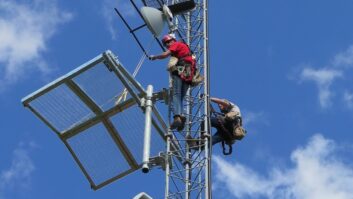Educator Says It’s Time for Radio to Leave the Warm Glow of the 12AV6
After reading letters to the editor and excerpts of publicly-filed comments from individuals opposed to the switch to IBOC, Ed Montgomery, an electronics and communications teacher for 34 years, prepared this opinion which he says refers “to another time when a broadcast signal was changed to provide better service even though it introduced what was considered a ‘penalty.'”
Human beings generally cling to the status quo. When something new comes along, trepidation often results.
When Thomas Edison developed electricity, the gaslight companies proclaimed the dangers of the new form of energy. “Get a horse!” was the cry for many at the turn of the 19th to the 20th centuries, when the automobile came on the scene.
My father would never buy a car with a radio or an automatic transmission. His standard response to the latter was, “The transmissions break.”
He was a firm believer that car radios didn’t work outside a specific area. We lived in northern New Jersey. He believed that if you got to Greenwood Lake, which borders New York, the radio would cease to operate. This was empirical evidence he acquired from using a company car with a radio.
What he never understood was that WAAT(AM) – now WWDJ – was a five-kilowatter that couldn’t send a signal that distance. It was the only station to which he listened.
Radio purists
But a lot of people like that act out of ignorance. Others use intentional deception to protect their products. The company with the slogan “the most trusted name in electronics” did all it could to suppress the development of FM broadcasting.
And among those who were there, who can forget Hollywood executives in the early 1950s writing off television, saying the average person would never exchange a giant theater screen for a small flickering box in their homes?
That battle created two classes of performers, writers, producers and directors: The elite Hollywood professionals, and the “underlings” in television, mostly based in New York City.
We live in an age of another group of purists who seem to believe that true radio broadcasting should consist of Heising Modulation at the transmitter and five tube superheterodyne receivers. These electronic Luddites fear any change to radio while EMI noise, iPods, Webcasting, satellite radio and those custom mix music CDs take more of the listening audience away each day.
Diversity of program distribution is taking listeners from the traditional broadcaster. Listeners are leaving and they are not likely to return, and this is affecting FM as well as AM.
It’s time to leave the warm glow of the 12AV6.
Listening habits have changed over the years. Two-income families have pretty much eliminated the DJ format with family-oriented humor between every song integrating their banter into the commercial clusters. Talk radio has gathered the political and sports demographics and the narrow rotation of some forms of music.
With just a few conglomerates owning most of the stations, the formats are very similar. A decade ago more nighttime radio stations were added to the old clear channel frequencies, adding more noise, limiting their effectiveness at great distances.
The primary service is the area that needs signal free from most noise with a good-fidelity stereo signal, at a minimum. The IBOC system can deliver that. Yes, it does inject noise in the first-adjacent sidebands in that primary zone; but few people have a need to listen to a station a time zone away any more.
Sixty years ago I would not have favored this change. But back then, living in a more rural America, we had broad-banded AM receivers and a need to hear Fred Allen, Eddie Cantor or the latest news from the war. That’s no longer the case.
The best way to describe what is happening is that the radio signals will change. Within the limits of keeping most of the analog signal, it is a small price to pay to reduce noise, improve fidelity and add more services.
‘Stereo penalty’
This is not the first time radio signals have changed.
When Edwin Armstrong developed wide-band FM he established 100 percent modulation as a frequency deviation of +/- 75 kHz producing the best signal-to-noise ratio. When subcarriers were added, the main channel modulation had to be reduced to accommodate them.
With FM stereo, sum and difference channels of equal loudness were transmitted, severely reducing the main channel deviation. The result was the “stereo penalty,” adding noise, often resulting in moving transmitters to better locations and increasing power. Even that didn’t always do the job, especially for the Class A stations.
The low receiver sensitivity of that era contributed to a reduced coverage area. The difference then was that there were far fewer FM listeners then than there are AM listeners today. I know of no complaints surrounding the addition of the stereo signal. Most say it saved the band.
There is another way to solve the digital broadcasting dilemma: Follow the path Armstrong did – developing an entirely new form of broadcasting, promoting it himself, fending off those who wanted him to fail. He gathered a significant number of listeners along The Yankee Network.
The battle with RCA was too much, costing his life; but his wife prevailed. There were no conglomerate owners back then, and a little more interest by local broadcasters to experiment.
Few have the willingness to do that today.
RW welcomes other points of view.












